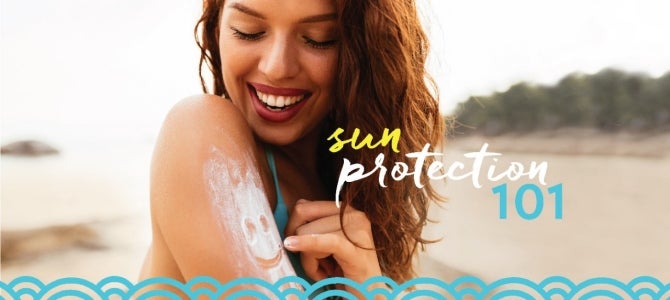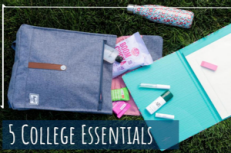13 Tips for Sun Protection: This Summer and Beyond
September 19, 2018

In the summer when the days are longer, and the sun is brighter, most people start thinking about their upcoming vacations—but few are thinking about how to protect their skin. In fact, only 34 percent of adults reported applying sunscreen with SPF 15 or higher,1 even though one-third of adults reported having a sunburn within the past year.2
If you’re among these numbers, now is the time to take some action in protecting your skin from the sun—not just in the summer but every single day of the year. Harmful ultraviolet (UV) rays don’t just show up from May to August, they’re around in every season. Read on for tips for protecting your skin from harmful UV rays all year long.
1. Layer up. Sunscreen works best when it’s combined with other sun protection. This can include wearing long-sleeve shirts, long pants, hats, and sunglasses while outside. You can also use lotions, sprays, gels, or lip balms with SPF to make sure you’re protecting every inch of your skin. If your cosmetics have an SPF of less than 15, don’t use them alone. Apply full-strength sunscreen to prevent sun damage.
2. Check the date. Most sunscreens have shelf lives of one to three years before they become less effective. Make sure to check the expiration date before you apply.
3. Get a helping hand. It can be hard to properly apply sunscreen to every part of your exposed skin. Get help when applying it to exposed, hard-to-reach areas like the back or scalp.

4. Reapply often. Even waterproof sunscreen wears off after swimming, sweating, or drying off with a towel. It can also rub off when you scratch your skin. Read the label to find out how long your sunscreen lasts but always reapply if you stay in the sun for more than two hours.
5. Use for every activity. You should be applying sunscreen whenever you’re out in the sun. This includes running, biking, walking, or even mowing the lawn.
6. Throw up some shade. The hours from 10 a.m. and 4 p.m. are peak times for sunlight. Make sure to stay in the shade as much as possible while the sun is at its brightest.

7. Watch out for clouds. Even on cloudy days, up to 80 percent of UV rays can penetrate skin.3 Make sure to use sunscreen every day all year round, even if it’s cloudy or cool.
8. Throw out those tanning beds. Using tanning beds is just as dangerous as lying out in the sun. If you want to get a sun-kissed glow, try a sunless tanning lotion that uses natural ingredients to keep skin moisturized.
9. Keep those numbers up. Sunscreen works to screen out UV rays—not completely block them. The higher the SPF, the less UV passes through. If you burn in 10 minutes without using sunscreen, SPF 15 will protect you for about 15 times longer, or 150 minutes. But these numbers are only accurate if sunscreen is perfectly applied. That can be difficult to achieve every time, so play it safe and reapply sunscreen more often than you think you should. Remember that no sunscreen can block 100 percent of UV rays, no matter the SPF.
10. Let it soak in. Most people only apply 25–50 percent of the recommended amount of sunscreen.4 Make sure you apply sunscreen in thick, generous layers and wait about 20 minutes before going out into the sun. Giving it some time to soak in will help the lotion properly bind to your skin. If you’re using spray sunscreen, make sure to spray a sufficient amount and rub it in well.
11. Avoid UVA and UVB. UVA rays age skin prematurely, causing age spots and wrinkles. These rays can even pass through windows. UVB rays primarily cause sunburns, but they are blocked by windows. Make sure to get a sunscreen that protects against both UVA and UVB rays.
12. Check your skin. UV ray exposure—from the sun, tanning beds, or sun lamps—is the most common cause of skin cancer which is the most common cancer in the United States. Anyone, no matter their race, gender, age, or skin tone, can develop skin cancer. Make sure to have your skin checked at least once a year by a skincare professional to watch for early signs of skin cancer.
13. Think ahead. Although skincare products can help reduce the appearance of sun damage, nothing is more effective than preventing sun damage from happening in the first place.

Protecting your skin from sun damage is so much more than quickly applying sunscreen. It involves a year-round awareness of the causes and consequences of UV ray exposure. Nu Skin works hard to create products that not only protect the skin but actively make it healthier. Take a look at Nu Skin’s line of sun protection products to keep your skin healthy and safe.
Resources:
1) https://www.cdc.gov/cancer/skin/basic_info/sun-safety.htm
2) https://www.cdc.gov/cancer/skin/basic_info/protect_infographic.htm
3) https://www.cdc.gov/cancer/skin/basic_info/sun-safety-tips-families.htm
4) https://theconversation.com/explainer-how-does-sunscreen-work-what-is-spf-and-can-i-still-tan-with-it-on-88869
YOU MIGHT ALSO LIKE:
-
Long hours in the library, falling asleep at your laptop, staying up all night to finish a paper, and getting up the nerve to sit by your crush – just a typical day in the life of a college student, am I right? Whether you are a freshman or a senior, we could all use a little something to help us get through the semester.
-
At Nu Skin, we live and breathe innovation. We were founded on innovative principles of doing things differently and believing that cosmetic and personal care products needed to be better than they were. Without innovation, Nu Skin would simply cease to exist.

